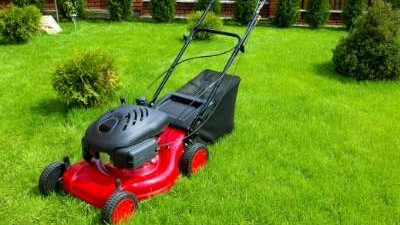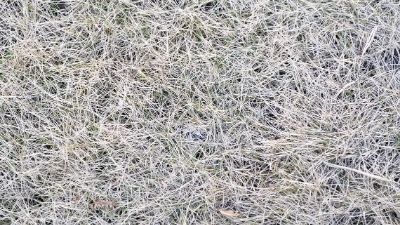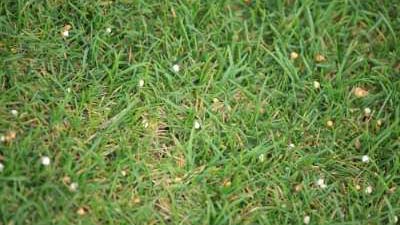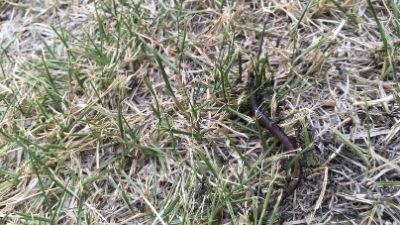Bermudagrass, is it here to stay?
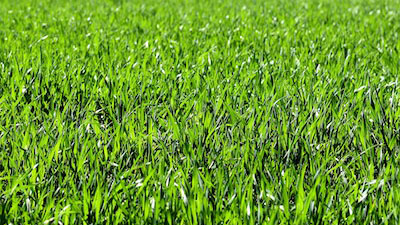
Common bermudagrass (Cynodon dactylon) has become a well established weed in many lawns and gardens throughout the southwest. It is sometimes grown intentionally as a turfgrass on golf courses, or lawns. It is also used in some areas as forage for livestock. Most of us however, are more familiar with it as an invasive weed. Bermudagrass was introduced to this country from Africa around 1750. It may spread from both stolons and seeds making it very difficult to get rid of. The newer hybrid varieties used in lawns and golf courses do not produce seed.
Mulch can be used effectively to manage bermudagrass. Black polyethylene applied over bermudagrass to prevent sunlight from reaching the plant can effectively control established plants. To accomplish this, mow and irrigate the grass, place the plastic over the plants, and leave it for at least 6 to 8 weeks in summer. Placing plastic over bermudagrass in winter will not control it. Be sure that the plastic remains intact without holes or bermudagrass will grow through the holes and survive. If ornamentals are planted in holes in the plastic, bermudagrass control is reduced.
Clear plastic mulching (solarization) is effective for eradication of bermudagrass plants and seed if it is applied during periods of high solar radiation (summer months). Before applying the plastic, closely mow the bermudagrass, remove the clippings, and water the area well. It is not necessary to cultivate before solarization, but a shallow cultivation may improve control. Place clear, ultraviolet (UV) protected polyethylene over the area. The plastic should extend roughly 2 feet beyond the bermudagrass stolons to make sure the infested area is covered; it must be maintained intact for 4 to 6 weeks. Shade will reduce the effectiveness of solarization because it limits the amount of radiation. Solarization works most effectively when there is no slope in the land or if there is, the slope has a south or southwest exposure. Temperatures are not as high under plastic placed on a north-facing slope; consequently control is not as effective. After solarization, do not cultivate the area deeper than 3 inches to avoid bringing weed seed into the upper soil layer.
Mulching with products such as wood chips is not effective against bermudagrass because the weed can push up this mulch. If organic landscape (geotextile) fabrics are used under the mulch, however, control can be achieved. The fabric must be overlapped so the stolons do not grow between the fabric sheets. If holes or gaps are present in the fabric, control will be reduced because bermudagrass is likely to grow through the holes. If any sunlight is allowed to penetrate the mulch, control is compromised.
Established stands of bermudagrass can be controlled in the landscape with postemergent herbicides. Post-emergent herbicides are applied to bermudagrass leaves and stems when they are growing vigorously (from spring to late summer). Selective herbicides (Poast) only kill the specific plants that they are targeted for (grasses). Nonselective herbicides (Roundup) kill nearly all plants they come in contact with. Because nonselective herbicides that control bermudagrass also kill or injure other grasses in turf, do not apply them to a mixed stand of turfgrass, unless you intend to kill other grass species as well.
For best control with selective herbicides, make an application in spring when new bermudagrass growth is less than 6 inches in length, then reapply the herbicide before the re-growth is more than 6 inches in length. Additional applications may be needed as new growth occurs. There may be limits to how much herbicide can be applied in a year so it is important to follow the label. Control is increased if the plant is growing well with plenty of leaf area. Roundup is translocated through green tissue. Plants that are drought stressed, insect damaged, or with dust on the leaves will not be controlled as well.
When using nonselective herbicides allow bermudagrass to green up and form a dense stand of 4- 6 inches. Apply to grass that is well watered and then withhold water for 7 days after application. After 14 days mow grass short or lightly cultivate and wait for it to re-grow. Then apply herbicide again. Try removing all clippings as these may reestablish themselves once they receive irrigation again.
Bermudagrass is one of the most tenacious weeds that we are faced with. Removal will require a dedicated effort for at least an entire season or longer. Stolons (shoots with roots) may lay dormant for a time and sprout once they receive irrigation, and soil temperatures have warmed sufficiently.
Published January 2005
Utah State University Extension
Peer-reviewed fact sheet
Download PDF
Authors
Rick Heflebower, Horticulture Agent
Related Research


